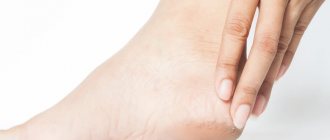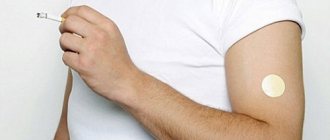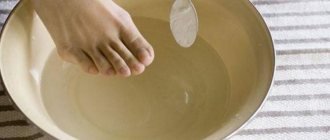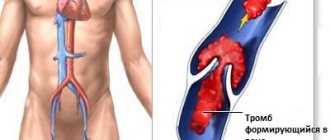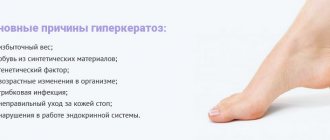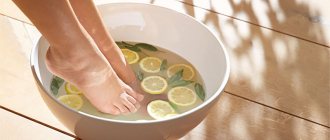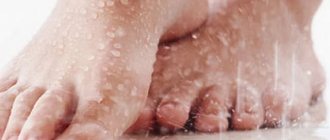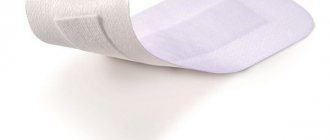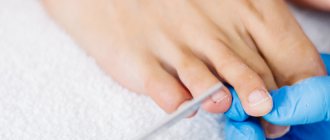Calluses and corns
A callus is the result of prolonged friction or pressure on the skin. Manifests itself in the form of keratinized areas (death of epithelial cells). Calluses are divided into two types: dry and wet. Their difference is that liquid accumulates at the site of callus formation, thereby forming a wet callus. Over time, wet calluses can turn into dry calluses, which have a deep core.
Calluses on the phalanges of the toes
Corns are a type of callus, which is characterized by thickening of the keratinized skin of the foot (heel area) without a core, due to which a person experiences severe pain and burning when walking.
Reasons for appearance:
The main reason for the formation is narrow shoes that rub the feet, as well as long walking or prolonged standing. Also, the cause may be diseases such as flat feet, diabetes, psoriasis, hypovitaminosis (lack of vitamins).
corns in the heel area of the foot
Reasons for appearance:
The main reason for the formation is narrow shoes that rub the feet, as well as long walking or prolonged standing. Also, the cause may be diseases such as flat feet, diabetes, psoriasis, hypovitaminosis (lack of vitamins).
Stages of callus development The first stage is redness, swelling, and mild pain in the area of friction. The second stage is characterized by the formation of a cavity in which intercellular fluid accumulates. When palpated, the callus causes pain. Redness may persist in the area where the callus forms.
Callus
Stages of development of corns:
The first stage - during the rubbing process, redness and swelling appear on the skin, and unpleasant sensations arise.
The second stage - a characteristic feature is the presence of gray or yellow areas. Cracks of varying depths may also appear on them.
Sensitivity in the area of corns formation is low. Pain occurs, but only when walking. They can only intensify when inflammatory processes occur.
Causes of calluses
Before getting rid of corns on your feet, you need to find out the main reasons for their appearance and eliminate them. Most often, calluses occur due to:
- using uncomfortable, narrow shoes or shoes of the wrong size;
- wearing hard shoes on bare feet or a very thin nylon sock;
- a heel that is too high, which causes compression and excessive stress on the forefoot;
- various foot diseases;
- walking barefoot for a long time;
- excessive sweating of the feet;
- wearing shoes with hard seams inside or with rubbing surfaces;
- wearing socks that are too large and cause wrinkles;
- selection of shoe models with thin soles.
The best ointments for calluses
The ointment for treatment should be selected depending on the type and depth of calluses. For corns, doctors recommend preparations based on lactic acid, salicylic acid and keratolytic agents - they soften, disinfect and exfoliate rough tissue. Wet calluses are pre-treated with an antiseptic and then a healing ointment is applied under the bandage.
Mozolin
4.9
★★★★★
editorial assessment
95%
buyers recommend this product
Mozolin includes benzoic and salicylic acids, which have a pronounced keratolytic effect. An additional component is lemon essential oil, which destroys bacteria and heals cracks. The composition softens the stratum corneum and is intended for dry calluses. Available for sale in 30 ml plastic packaging.
Advantages:
- bactericidal effect;
- softening and natural moisturizing of the skin;
- nice smell;
- minimum side effects;
- affordable price.
Flaws:
- not suitable for children under 3 years of age.
Callus is applied to the steamed callus, a gauze bandage is applied on top, secured with a band-aid for 6-8 hours and then the softened tissue is removed with pumice. Procedures are carried out daily until the problem is completely resolved.
Diprosalik
4.8
★★★★★
editorial assessment
91%
buyers recommend this product
Diprosalik ointment has keratolytic and anti-inflammatory properties. Its active ingredients are salicylic acid and betamethasone dipropionate. The drug softens the outer layer of skin and helps exfoliate calluses from rough feet. In addition, the ointment is in demand for the treatment of psoriasis, eczema, lichen, and dermatitis. Sold in 30 g aluminum tube.
Advantages:
- relieves swelling;
- destroys harmful bacteria;
- softens the skin;
- facilitates the removal of keratinized areas.
Flaws:
- may cause an allergic reaction.
Diprosalik ointment has proven itself in the treatment of dry and core calluses, especially if their appearance is accompanied by a bacterial or fungal infection.
Sintomycin 10%
4.8
★★★★★
editorial assessment
89%
buyers recommend this product
Syntomycin ointment contains 100 mg of chloramphenicol, castor oil, sorbic acid. This is a broad-spectrum antibiotic recommended for the treatment of burst blisters. The drug blocks the infectious process, accelerates healing, and minimizes pain. Sold in 25 mg dark glass jars.
Advantages:
- destroys microbes;
- dries out the skin;
- relieves inflammation;
- increases blood flow;
- it's cheap.
Flaws:
- not suitable for people prone to allergies.
Doctors prescribe Syntomycin if the blister is injured and an infection has entered the wound. The ointment is applied in a thin layer and sealed with a bactericidal plaster.
Pasta Dr. Foot
4.6
★★★★★
editorial assessment
90%
buyers recommend this product
Pasta Dr. Foot consists of urea, allantoin, celandine and D-panthenol. These substances soften the roughened epithelium, removing dead skin layer by layer. The ointment regenerates damage, softens and has a powerful antiseptic effect. Designed to care for rough skin and remove corns. Sold in tubes of 20 ml.
Advantages:
- restores the elasticity of the dermis without drying it out;
- promotes the formation of healthy epithelium;
- helps with old dry calluses.
Flaws:
- long course of treatment.
To get rid of corns, Dr. Foot will have to be used for at least a week, strictly following the instructions.
READ ALSO
12 best foot creams
How to get rid of calluses on your feet yourself
The easiest way to cure a water callus is to wait for it to burst, or to pierce it yourself. However, it is important to take care of disinfection, otherwise there is a risk of infection.
When deciding how to get rid of dry calluses, you need to take into account the area and depth of the lesion. For example, a small thickening on the little finger can be removed with a pedicure file or pumice stone. You may first need to soften the skin in a hot bath with the addition of various components.
Dry calluses on the foot can also be removed by applying salicylic ointment at night or by sticking a special medicated patch.
However, doctors do not recommend removing calluses yourself, as there is always a risk of damaging the skin and causing infection, which will create additional problems and complicate treatment.
Types of dressing materials
You need to choose a patch for calluses on your hands and feet taking into account the type and degree of skin damage, the purpose and composition of the impregnation. A properly selected dressing heals the wound, protects it from pathogenic microorganisms, cleanses and disinfects the skin, and promotes healing.
Manufacturers produce silicone, salicylic and liquid patches. The first ones are made of silicone gel, glued to any area of the body, and are invisible when worn. The latter contain salicylic acid, which softens the rough layer of skin. In addition, such a callus plaster for core calluses has an antiseptic and antibacterial effect. Liquid products are compositions that form a protective film on the damaged area. It does not interfere with air exchange and accelerates healing.
How doctors remove calluses
The fastest, safest and most painless method is hardware procedures. Removal of the formation is carried out using a special cosmetology device equipped with an automatic cutter fixation system. This eliminates the risk of soft tissue damage. The procedure itself is painless and does not require special preparation. The session time ranges from 10 to 60 minutes. It depends on the number of dry calluses and the degree of their neglect.
Before starting work and during the procedure, the skin is thoroughly disinfected. In case of increased sensitivity, the patient is given topical anesthesia. When treating calluses and corns, the skin is cooled using a spray.
After removing a callus or corns, the skin is polished, and the edges of the treated area are smoothed so that there is no discomfort when walking later. After completion of the procedure, the treated surface is protected with a bandage.
In this way, you can remove any corns, including dry calluses on the foot.
Features of hardware procedures:
- absolute safety – the surface being treated is thoroughly disinfected, which eliminates the risk of infection;
- speed – unlike home procedures, the removal of corns and calluses in a cosmetology clinic is performed quickly and efficiently. One procedure is enough;
- painlessness – automatic fixation of the cutter on the equipment protects the skin from accidental injury and pain;
- no contraindications – anyone can use hardware callus removal.
Callus
Calluses can be especially painful. In the center of the callus there is a hole from which the head of the callus protrudes. This head covers the root, which goes deep into the soft tissues and causes pain when walking.
Such a callus can form as a result of a foreign body (for example, a splinter or a pebble) getting under the skin. If the splinter is not removed, when it moves, it begins to irritate the tissues surrounding it, and the body, in response to irritation, forms a corpus callosum, but not from the outside, but from the inside. Another reason for the appearance of calluses is a dermatotropic virus.
Recommendations after removing dry calluses on feet
After hardware removal of calluses and corns, it is recommended to wear loose shoes made from natural materials. It is better to give up high heels for 2 weeks, and also not visit swimming pools and saunas for a month. It is better to treat the skin with a disinfectant composition.
Patients who successfully get rid of dry calluses experience lightness in their legs and no pain while walking.
It is better to prevent the occurrence of corns and regularly remove rough skin on the feet. By periodically undergoing a medical hardware pedicure procedure, you will not be aware of such problems as rough skin on your feet and the occurrence of complications.
If you want to remove dry callus, contact the SM-Cosmetology clinic. At the initial consultation, the podologist will conduct an examination and select the optimal method to solve your problem. You can remove calluses and corns after one visit to a cosmetology clinic.
—>
Indications and contraindications
Before using a silicone patch for calluses on your feet, you should read the instructions, including indications and contraindications for its use.
The patch should be used in the following cases:
- as soon as the callus is discovered;
- if the formation is accompanied by discomfort and pain;
- at risk of a crack;
- to protect the lesion from infection.
Contraindications for use are the presence near the callus:
- cracks;
- open wounds;
- scratches and bruises;
- papillomas and moles.
Components that impregnate the patch can cause negative reactions on open wounds - pain, burning, swelling, etc.
4.Treatment
When opening a soft callus at home, the first priority is antiseptic measures: the affected area should be thoroughly washed and disinfected, the needle should be sterilized (it is better to use the sterile needle included with any disposable syringe). After opening and expiration of the contents, the wound surface should also be treated with a disinfectant solution, carefully remove flaps of dead skin with a sterilized manicure instrument (do not tear off under any circumstances!), apply antibiotic ointment and, if necessary, a protective bandage or bactericidal patch. There is also a wide range of traditional medicine, the consideration of which is beyond the scope of this article.
To eliminate and prevent dry calluses, therapeutic and hygienic creams, gels, ointments, and liquids are offered; You can also find countless recommendations for steaming, using pumice, softening compresses, etc. However, it is more important to remember the following.
At the first signs of an infectious-inflammatory process, as well as when a rapid change in the size, shape, color of the callus and/or sensations associated with it begins, you should immediately consult a doctor (surgeon or dermatologist). Currently, many methods for the safe removal and treatment of calluses are successfully used, taking into account the individual nuances of each case: radio wave, laser, cryotherapeutic, microsurgical techniques.
The best pencils for calluses
Callus sticks are a good alternative to regular plasters. These are small sticks with a compressed gel-like rod. In addition to anti-callus, pencils have an antifungal effect. They soften the keratinized dermis, heal wounds, relieve pain and create an invisible protective layer that protects the skin from infection and new abrasions.
Kinexib stick
4.9
★★★★★
editorial assessment
94%
buyers recommend this product
The transparent stick forms a reliable layer between the skin and shoes, reducing friction and also preventing the formation of calluses and abrasions. Contains vitamin E, aloe vera, dimethicone, menthol. These ingredients moisturize the skin, soothe irritation, and provide a slight cooling effect. The stick with a roll-on applicator is sold in transparent packaging.
Advantages:
- convenient bottle;
- no odor;
- elimination of swelling;
- protection against chafing;
- effective removal of roughness.
Flaws:
- the treatment must be repeated several times during the day.
The Kinexib stick prevents the appearance of wet calluses and helps to fade existing abrasions.
Express applicator Scholl 2 in 1 Corn Express
4.8
★★★★★
editorial assessment
90%
buyers recommend this product
The Scholl applicator contains salicylic acid and panthenol, which dry out watery calluses and soften keratinized calluses. The patented formula provides a bactericidal and disinfectant effect and protects against painful, unaesthetic abrasions. The pencil soothes inflamed skin after the first use.
Advantages:
- softens rough skin;
- quickly stops the inflammatory process;
- accelerates regeneration;
- moisturizes.
Flaws:
- ends quickly;
- may cause allergies.
In rare cases, Scholl 2 in 1 Corn Express may cause irritation, so it is advisable to test for an allergic reaction before use.
2. Reasons
The immediate cause of the formation of calluses on the skin is a local mechanical effect, stereotypical in nature (repeated friction, vibrating pressure, etc.). If in a given area the combination of intensity and duration of such exposure exceeds a certain threshold of strength, stability, and density of the skin, the cellular layers are damaged, regenerative mechanisms do not have time to restore the tissue, and certain pathological changes begin in it, which, again, depend on the strength , duration and vectors of mechanical irritation.
With strong friction, unusual for any area, a callus can form and spontaneously open in a matter of minutes; on the contrary, with soft, almost imperceptible, but constant pressure and rubbing, years may pass until the skin thickens and hardens adequately to the impact. In general, the adaptive capabilities of skin tissue are very great: it can adapt (hardening, as they say, to stone hardness) even to oars, a shovel or a heavy lumberjack axe.
The most typical origin of calluses is working with hand tools and equipment, playing musical instruments (especially stringed ones), and regular training on sports equipment. An extensive and diverse group is also formed by calluses associated with shoes: improperly selected, tight or too loose shoes that do not correspond to individual orthopedic features (flat feet, high instep, joint inflammation, etc.), rough and simply poorly cut and sewn shoes can become cause serious problems.
Visit our Therapy page
